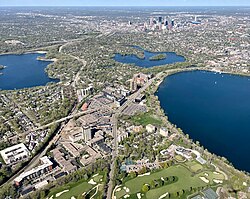West Maka Ska | |
|---|---|
 West Maka Ska (middle/bottom) with Bde Maka Ska on right and Minneapolis in the background | |
 Location of West Maka Ska within the U.S. city of Minneapolis | |
| Country | United States |
| State | Minnesota |
| County | Hennepin |
| City | Minneapolis |
| Community | Calhoun-Isles |
| City Council Ward | 7 |
| Government | |
| • Council Member | Katie Cashman |
| Area | |
• Total | 0.674 sq mi (1.75 km2) |
| Population (2020) [2] | |
• Total | 2,645 |
| • Density | 3,920/sq mi (1,520/km2) |
| Time zone | UTC-6 (CST) |
| • Summer (DST) | UTC-5 (CDT) |
| ZIP code | 55416 |
| Area code | 612 |
| Census | Pop. | Note | %± |
|---|---|---|---|
| 1980 | 1,595 | — | |
| 1990 | 1,874 | 17.5% | |
| 2000 | 1,865 | −0.5% | |
| 2010 | 1,740 | −6.7% | |
| 2020 | 2,645 | 52.0% |
West Maka Ska, formerly known as West Calhoun, is a neighborhood in the U.S. city of Minneapolis. The neighborhood was generally rural with a couple grain silos along the railroad track heading into Downtown Minneapolis until about the 1910s. Although the railroad still runs through the neighborhood, the neighborhood is now mainly homes, apartment buildings, and strip malls. [3]
Contents
West Maka Ska is the southwestern-most neighborhood of the Calhoun Isles community in the western part of the city. It is in Ward 7, represented by council member Katie Cashman. [4]
The neighborhood is bordered on the east by East Bde Maka Ska, the north by Cedar-Isles-Dean, the south by Linden Hills and the west by the city of St. Louis Park. Its boundaries are Lake Street to the north, Bde Maka Ska to the east, 36th Street to the south, and France Avenue to the west.